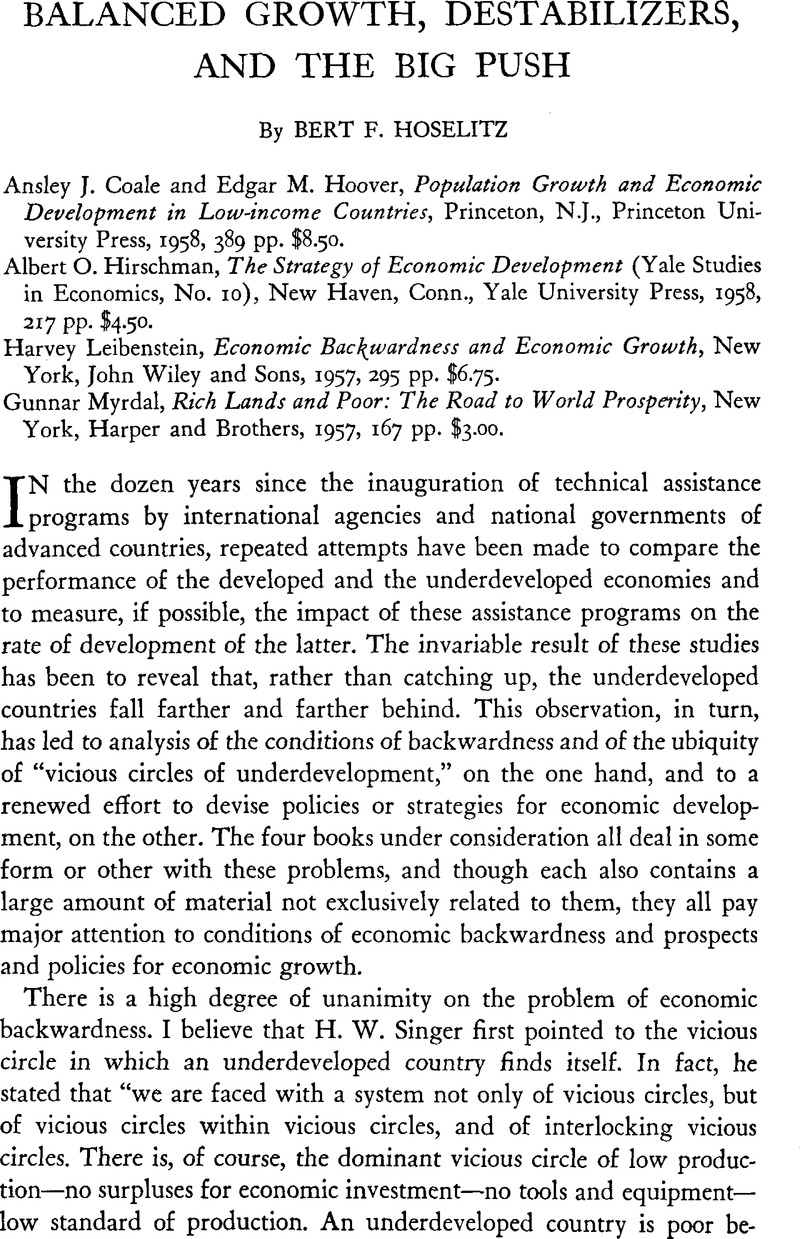No CrossRef data available.
Article contents
Balanced Growth, Destabilizers, and the Big Push
Published online by Cambridge University Press: 18 July 2011
Abstract

- Type
- Review Articles
- Information
- Copyright
- Copyright © Trustees of Princeton University 1960
References
1 Singer, Hans W., “Economic Progress in Underdeveloped Countries,” Social Research, XVI, No. 1 (March 1949), p. 5.Google Scholar
2 Nurkse, Ragnar, Problems of Capital Formation in Underdeveloped Countries, Oxford, 1953, pp. 11–31Google Scholar; Center for International Studies, MIT, The Objectives of US. Economic Assistance Programs (A study prepared at the request of the Special Committee to Study the Foreign Aid Program, U.S. Senate), Washington, D.C., 1957. pp. 70–71.Google Scholar
3 Rosenstein-Rodan, P. N., “Notes on the Theory of the ‘Big Push,’” Center for In ternational Studies, MIT, Economics Development Program, Italy Project, C/57–25, Cambridge, Mass., 1957, p. 14.Google Scholar
4 The fact should be emphasized that in this example we are dealing with a closed economy. For if we assume an open economy, the consequences described in the text may not arise, since the dishes produced by the new plant may find a market abroad, or even a domestic market, replacing previous imports. It should be noted, however, that this difference between a closed and an open economy is valid only up to a certain point. Though the existence of open economies may reduce the degree of indivisibility on the demand side, it does not eliminate it completely.
5 One way of stating the policy recommendations flowing out of the theory of the big push is exhibited by the following passage from Lewis', W. Arthur book, The Theory of Economic Growth, Homewood, Ill., 1955.Google Scholar Lewis says: “The conclusion of this analysis is not very startling; it is that in development programmes all sectors of the economy should grow simultaneously, so as to keep a proper balance between industry and agriculture, and between production for home consumption and production for export” (p. 283).
Though Lewis shows that this formula deviates from the practice in Communist countries, where industry is pushed at the expense of agriculture, and from the recommendations of “liberal” economists who would “urge upon the agricultural countries … that they should concentrate upon agriculture” (ibid.), it gives little guidance to the harassed planner or programing officer in an underdeveloped country. It states, in very general terms, that capital formation is a good thing, that a little more of it is better than a little less—as is usually the case with a good thing—and that it matters little what special pattern of capital formation is selected, provided that one does not go whole hog in a single direction. It may well be that this is the best economists have to offer at present, but if it is, we are in poor straits, indeed.
6 Hoselitz, Bert F., “Patterns of Economic Growth,” Canadian Journal of Economics and Political Science, XXI, No. 4 (November 1955), pp. 416–31.CrossRefGoogle Scholar
7 Oshima, Harry, “Economic Growth and the ‘Critical Minimum Effort,’” Economic Development and Cultural Change, VII, No. 4 (July 1959), p. 475.Google Scholar




